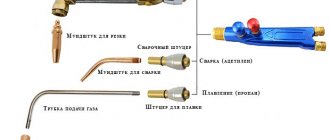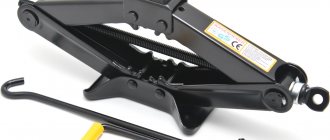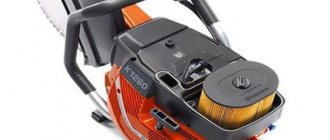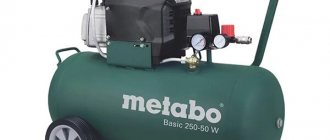What is a ratchet wrench used for?
Ratchet wrenches
for socket heads - these are the most popular and frequently used devices. With them you can unscrew fasteners with a square slot and secure socket heads with the desired shank.
Interesting materials:
Which wax to choose: soy or coconut? Which wireless earphone should you choose? Which budget oven to choose? Which blender to choose for smoothies? Which sofa to choose with springs or foam? Which Apron to Choose for a White Kitchen? Which flux to choose for soldering microcircuits? Which camera to choose for a beginning photographer in 2022? Which brick to choose for cladding a house? Which spray gun to choose for painting walls?
2021
Scroll up
Advantages of using a ratchet wrench
Using this tool provides a number of advantages, including:
- To tighten or unscrew the fastener, you will need to turn the ratchet with a little force. This allows you to work with large bolted connections (where maximum force is needed).
- Replacing a ratchet with a wrench increases productivity.
- The tool in question copes better with the task when working with bolted connections in hard-to-reach places. Nothing can be said about the classic analogues. The ratchets cope with the task even when it is not possible to throw the wrench.
All about socket heads: types, profiles, head sizes in inches and mm
Socket heads: what is important to know?
Socket heads, they are also socket wrenches, they are also socket wrenches. All heads can be divided into 2 large groups.
The first group is heads with a through hole (under the knob). The size range starts from 17mm.
The main advantage of these wrench heads is that to work with them
you do not need a special wrench, which for large heads costs much more than the head itself.
You can use a pry bar or any other wrench of a suitable diameter. Among the disadvantages, we note the inability to work in confined spaces and with recessed fasteners. It is not possible to use an extension cord for work. The second group is heads with a connecting square under the knob. The size range starts from 4mm.
It is worth telling more about this group. For convenience, we will divide the group according to certain parameters. The first parameter is the size of the connecting square. The connecting square or landing square is a tetrahedral hole on the back of the head. The size of a square is measured in units that are unusual for us - inches. Inch from Dutch duim - thumb). An inch is indicated by a double stroke ” and is equal to 25.4 mm. Interestingly, the OIML (International Organization of Legal Metrology) considers the inch to be a unit of measurement that should be phased out as soon as possible and that should not be introduced where it is not currently used. In the Russian Federation, the inch is approved for use as a non-systemic unit without a time limit with the scope of application “industry”. 5 most popular standard sizes of connecting (landing) squares. 1″, 3/4″, 1/2″, 3/8″, 1/4″. Frequently asked question: how much is it in millimeters? Answer:
- 1 inch = 25.4 mm,
- 3/4 inch = 19.05 mm,
- 1/2 inch = 12.7 mm,
- 3/8 inch = 9.53 mm,
- 1/4 inch = 6.35 mm.
The larger the connecting square, the more powerful the head. The wall is thicker, the maximum load is higher. For example, a 27mm head. can be with connecting squares: 1/2″, 3/4″, 1″. Naturally, the wall thickness and safety margin will increase when moving to a larger connecting square.
The size range of heads is also tied to the size of the connecting square.
- Square 1/4″ - heads from 4mm to 14mm.
- Square 3/8″ - heads from 6mm to 24mm.
- Square 1/2″ - heads from 8mm to 36mm.
- Square 3/4″ - heads from 17mm to 70mm.
- Square 1″ - heads from 36mm to 80mm.
The second parameter is applicability. 1. IMPACT heads for working with pneumatic and electric tools. The heads are designed to withstand shock loads. Made from high quality steel with added molybdenum (Mo) for toughness. Typically oxidized, black.
Unlike standard heads, they have a thicker wall, although there are also thin-walled impact heads, for example, for working with cast discs.
2. Heads are STANDARD. Designed for manual work with a crank.
Protected from corrosion by galvanizing or chrome plating. All heads on our website: https://vk.cc/5OlLOI The third parameter is the head profile. 1. Twelve-sided profile. Heads with this profile allow you to work with both hexagonal and twelve-sided fasteners.
2. Standard hexagonal profile. The most common, most tool sets are equipped with heads with exactly this profile.
3. Hexagonal profile SuperLock, Surface, Multidrive. The profile is similar to a hexagonal one, but the contact area with the fasteners is increased. Heads with this profile are shown for working with licked fasteners; inch fasteners can also be unscrewed. We talked about this profile in detail here
4. TORX profile or E-standard. These heads are designed for unscrewing fasteners with a TORX profile (6-point star)
The fourth parameter is the height of the heads. The heads are high.
Standard height heads.
All new items
Socket heads. Landing square.
Sockets are a universal and necessary tool for car maintenance. No repair can be done without them. No, of course you can only use open-end wrenches, but why such sacrifices? The heads are much more convenient to use, and you can apply more force to them without fear that the tool will come off the fastener.
Socket heads are a replaceable attachment for assembled metalwork tools, which differ in the connecting square, profile, size and depth. A single head can hardly be called a tool, since it requires at least a knob to function. Or better yet, a whole set of “body kit” in the form of extensions, a universal joint, a ratchet and other useful additions.
Landing square of socket heads.
On one side of the socket head there is a working profile, which is used to attach it to fasteners (for example, to a nut). On the second side there is a connecting (landing) square with which the head is attached to the collar or ratchet. The size of the connecting square is measured in inches, and can be: 1/4 inch, 3/8 inch, 1/2 inch, 3/4 inch, 1 inch. The smallest is 1/4, the largest is 1. The size range and the maximum force that the head can withstand depend on the size of the landing square.
Source
Characteristics of the first model
Turning the reverse on/off for this model is done by clicking the square core in the central part of the instrument from one side to the other.
When clicking the core, the key will need to be turned in the opposite direction than it was before clicking.
The head is held using a specially built-in spring ball, as shown in the picture above.
The working head of the tool can be put on and removed without much effort, but the seat square, when removing the head, may end up either in the key or in the head itself.
This is due to the simple design of the tool.
Simplicity is also expressed in the fact that this instrument has only 15 teeth.
The locking mechanism here is also very simple and consists of a gear with special grooves and a bushing.
The mechanism is stopped by a bushing that is pressed against the drum with a special plug.
As a result, the gear rotates in one direction and stops in the other, resting against the bushing.
A characteristic feature is that this all-metal tool has a plug made of plastic, which is a disadvantage.
Because As soon as you unscrew it and tighten it a couple of times, the thread on it wears off and it becomes unusable.
To extend its service life, you can use some polyethylene or the like as a seal.
Reliability
There is an opinion that ratchets with a large number of teeth are less reliable and break easily.
This is partly true, but it all depends on the manufacturer and the quality of the ratchets.
Tools with more teeth use slightly different locking mechanisms.
To see this, we disassemble models with 24 and 72 teeth.
This is quite easy to do, just unscrew the fixing bolts using a suitable star-shaped attachment.
The 24 tooth option is the one we considered second, it has a large pitch.
In the analysis, we see a locking mechanism in the form of two plates, supported by springs, which cling to 1 tooth of the gear, each on its own side.
When turning in one direction, one locking plate works, and when reverse is turned on, the rotation already goes in the other direction, and another locking plate works.
In a tool with 72 teeth, you can see that the teeth are noticeably smaller and of course there are more of them.
The locking plates here have a more complex shape, and they cling to 3-4 teeth.
Bits and Sockets Guide. Marking of all sockets and bits
Individual tool sets contain more than a hundred different bits and sockets. But how many of them can you use at home or in your workshop? Some of them are completely different from the bits and sockets you use at home or on a construction site, because they are intended for specific industries, such as the furniture industry, specialized car repair shops, or repair shops for household appliances and electronics. In this guide, we will describe what types of bits and sockets there are, so that you can figure it out and understand what is worth buying, and which bits you will never need in your life.
Straight slot bits (SL)
A slotted slot (SL) is a simple recess for a flathead screwdriver. It looks like a slot made in the head of a screw or self-tapping screw. A distinctive feature of a straight slot is the small contact area between the tool and the fastener (when the bit or screwdriver rotates, its edges touch the inner surface of the slot at only two points). Therefore, the SL (or Slot) flat slot is completely unsuitable for tightening fasteners with high torque. Despite its simplicity and versatility, it is used less and less these days (mostly only for tasks that do not require a lot of tightening force).
Spline bits are found in almost every set of replacement bits, including the most budget ones. In the marking they are designated by the letters SL and numbers indicating the width of the blade in millimeters. In everyday life, it is useful to have at least two or three bits with a width from SL4 to SL8 (and flat screwdrivers of small and large sizes are usually needed only by specialists).
Phillips bits (PH, PZ)
Phillips-head fasteners and corresponding screwdrivers for them appeared in the 30s of the last century, when the characteristics of flat-head screws were no longer suitable for the engineering industry. A cross-shaped slot in the “head” of a screw or self-tapping screw allows you to accurately center the tool, and four planes of contact between the Phillips screwdriver or bit and the inner surface of the slot ensure the transmission of increased torque. Therefore, fasteners with cross-shaped slots can be tightened with much greater force without fear of “licking” the head or damaging the tool.
There are about a dozen varieties of Phillips splines, but in practice only two are used: Phillips (PH) and Pozidriv (PZ).
The PH cross recess has been developed specifically for pneumatic and electric screwdrivers. It looks like a cross-shaped slot with a slight thickening in the center. The corresponding bits and screwdrivers are marked with the letters PH and numbers indicating the size: 0000, 000, 00, 0, 1, 2, 3 and 4. Most often, the sets include bits in sizes PH1 to PH3, and the rest may be needed only for highly specialized tasks.
The PZ cross spline is visually different from the PH. Additional “whiskers” are visible on the surface of the Pozidriv slotted fastener head, and corresponding “ribs” are visible on the PZ bits. These additional elements allow even more torque to be transmitted than the PH spline. Screwdrivers and bits of this type are marked with the letters PZ and a numerical designation of the size: from 0 to 5. The type most needed on the farm is the PZ2 bit (almost all Pozidriv type screws that you may encounter in everyday life or at a construction site will be of this size ).
Despite their external similarity, cross tips of different standards are not completely interchangeable. The fact is that the edges of the Phillips slot are slightly beveled at a slight angle, and the internal surfaces of the cross slot of the Pozidriv standard are vertical. Because of this feature, PH type tools tend to be pushed out of the slot under high torque conditions, while PZ bits do not have this drawback. Therefore, although PH bits can be used to tighten PZ fasteners (but not vice versa), it is still better to use the appropriate tool for each type of fastener.
Bits for square and hexagonal slots (SQ, Hex)
Quad and hex splines appeared as an alternative to Phillips splines when it became necessary to increase the torque when tightening screws without increasing the size of their heads.
SQ (Square) bits for Robertson slots have a tip of the working part in the form of a square profile. Their markings indicate numbers indicating the size (from 0 to 4). Screws and self-tapping screws with square slots are not common, but you may need SQ bits if you do auto repair (especially Canadian-made ones) or carpentry. The most useful square bit sizes are SQ2 and SQ3.
Hex bits (Hexagon, Allen) for Allen slots have a working part in the shape of a regular hexagon. The corresponding fasteners are used very widely, especially in the furniture industry. Even ordinary plastic windows are adjusted using hexagons (but special elongated keys are usually used for this). Bits of this type are designated by the letter H and numbers indicating the size (the distance between opposite edges). In everyday life, the most useful and in demand tool is the size from H3 to H6. There are also “anti-vandal” bits HH (Hex Hole, Hex Tamper Resistant or Hex Tamper Proof) with a hole in the center.
Torx bits (T, TX, TH)
Star spline fasteners and tools for working with them came into use more than 50 years ago, when complex equipment and industrial robots appeared on automotive assembly lines. The six-pointed star shape significantly increases the contact area between the bit and the slot. This allows you to tighten fasteners with very high force without damaging the head and working edges of the tool. There is almost no tendency to push the bit out of the slot, so the screwdriver or screwdriver does not need to be pressed axially during operation.
Types of ratchet wrench
Two tool options have been developed for working with fasteners:
- Cap . Outwardly similar to a classic box wrench. Equipped with two working parts, different in size. This is convenient if during work you need to change the key to a larger one without interrupting the process. The ring ratchet has found application in car repair and maintenance. The presence of thin walls of the head of the wrench (for example, Jonnesway W681415) allows the tool to get into hard-to-reach places and transport nodes.
- Socket tool . This is the most popular type of wrench, with a square slot for heads for fasteners.
In addition, ratchets are divided into 4 types, taking into account the size of the nozzles:
- 1⁄4 - the size of the nozzles is 4-14 mm. The tool is used when working with small-sized threaded connections located in hard-to-reach places.
- 3⁄8 – head size 8-22 mm. These are not particularly popular, but in vain. Craftsmen recommend confidently buying such tools for work at home and for repairing a passenger car.
- 1⁄2 - size 8-22 mm. This is a popular type of key. But you need to work with it carefully, especially when tightening 8-10 mm nuts. If you do not calculate the force, there is a risk of breaking the thread or head of the fastener.
- 3⁄4 - size 19-46 mm. This is the largest tool that has become widespread in the manufacture and repair of heavy equipment and large structures.
Ratchet wrench device
Steel is used for manufacturing:
- chrome vanadium;
- stainless;
- chrome molybdenum;
which gives the tool mechanical strength and resistance to corrosion.
The design of the wrench involves a handle and a head with a ratcheting mechanism, thanks to which the fasteners are unscrewed without tearing off the tool. The rotating mechanism is located in a closed mouth. The mechanism rotates in one direction or in two. In the first case it is a one-way key, and in the second it is a two-way key.
Socket set for ratchet wrench
The direction of rotation is changed by a switch, which can be a disk or a flag. The presence of a gear with teeth (24-72) ensures rotation. The greater the number of teeth, the smoother the operation of the tool.
Standards used to designate socket heads
Today we will talk about the standards adopted to designate such a widely used tool in repair as a socket head. Thus, we will begin a whole series of articles devoted to abbreviations and abbreviations used by manufacturers to designate hand tools. This need is due to the fact that we often spend a lot of time trying to correctly understand what our clients need. And we'll start with the socket heads.
In their designation, socket heads have two dimension parameters: the size of the head itself and its “mounting” or “connecting” square. In addition, socket heads have three “design” parameters: head profile, head depth, and head alloy type.
To accurately designate the socket head, it is necessary to indicate: the type of steel; length (height); profile; Name; working size; size of the connecting square; brand (manufacturer). Example: 17mm 1/2” King Tony impact socket.
For the metric system, the dimensions of socket heads from the manufacturer King Tony imported to Russia are the following row in millimeters:
4, 4.5, 5, 5.5, 6, 7, 8, 9. 10, 11, 12, 13, 14, 15, 16, 17, 18, 19, 20, 21, 22, 23, 24, 25, 26, 27, 28, 29, 30, 31, 32, 33, 34, 36, 38, 39, 41, 46, 48, 50, 51, 52, 53, 54, 55, 56, 57, 58, 59, 60, 63, 65, 70, 71, 75, 77, 80 mm.
For the inch system, the dimensions of socket heads from the manufacturer King Tony imported to Russia are as follows in inches:
5/32, 3/16, 7/32, 1/4, 9/32, 5/16, 11/32, 3/8, 7/16, 15/32, 1/2, 9/16, 19/ 32, 5/8, 11/16, 3/4, 13/16, 7/8, 15/16, 1, 1-1/16, 1-1/8, 1-3/16, 1-1/ 4, 1-5/16, 1-3/8, 1-7/16, 1-1/2, 1-9/16, 1-5/8, 1-11/16, 1-3/4, 1-13/16, 1-7/8, 1-15/16, 2, 2-1/16, 2-1/8, 2-3/16. 2-1/4, 2-5/16, 2-3/8, 2-7/16, 2-1/2, 2-9/16, 2-5/8, 2-11/16, 2- 15/16, 3-1/8 inches.
One inch in the metric system is equal to 25.4 mm. Thus, although inch and metric heads are close in size, their dimensions do not completely coincide. This is why our metric sockets are not suitable for servicing vehicles or equipment manufactured for countries with inch measurement systems.
The second dimension parameter – the “connecting” or “landing” square – is the size of the square hole on the back side of the socket head. It determines which sockets, extensions, or ratchets you can attach to the socket. There are five main standard sizes of the connecting hole, called “square” for short, and all of them are indicated in inches. Thus, regardless of which socket head you have - metric or inch - its connecting square can have the following dimensions in inches:
1/4, 3/8, 1/2, 3/4, 1 inch.
• 1/4 inch = 6.35 mm • 3/8 inch = 9.53 mm • 1/2 inch = 12.7 mm • 3/4 inch = 19.05 mm • 1 inch = 25.4 mm
Heads with different connecting squares have different designs. The larger the connecting square, the thicker the walls of the socket head and, accordingly, the greater the load that it can withstand. A 13 mm socket with a 1/4 inch square connection and a 13 mm socket with a 1/2 inch square are completely different in strength and product design.
The size of the heads is also tied to the connecting square. For example, 1/4" square sockets are produced in dimensions only up to 14 mm, 1/2" square sockets - up to 32 mm (as a special series - up to 36 mm). This is due to the fact that the larger the size of the socket head, the greater the forces it must cope with, but there is a design limit after which it is impossible to ensure sufficient strength of the head without thickening its walls and moving to a larger connecting square.











